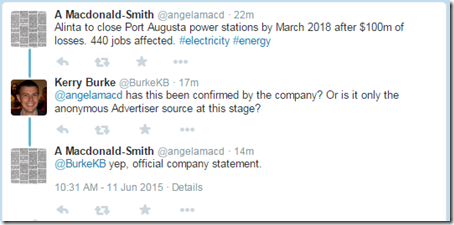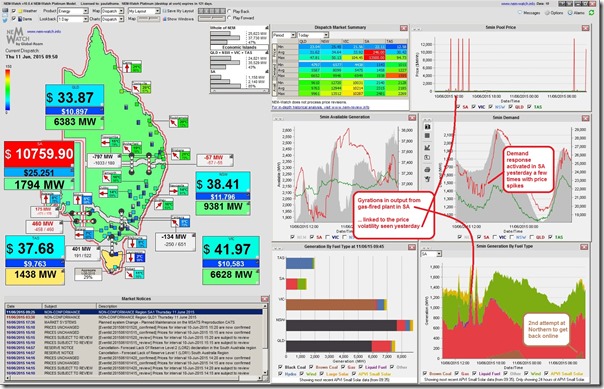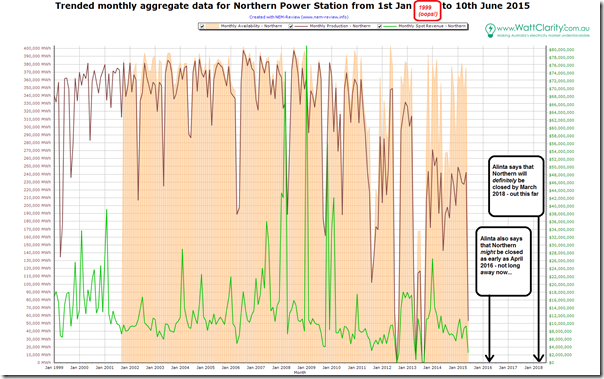With our brave Captain Tony on the “Team Australia” tinny carrying on the Quixotic quest today – tilting at windmills because of their poor visual amenity (see note below), accompanied by the customary squawking from the gaggle of onlookers on social media, I would have easily missed the somewhat more significant announcement made today in the energy space – except for the eagle eyes of two journalists, both:
(a) Angela MacDonald-Smith in the FinReview
(b) Matt Chambers in the Australian
Matt’s tweet references this article here from Meredith Booth. In this article, Alinta CEO Jeff Dimery is quoted as saying the closure of Northern Power Station (and associated mine) could happen “as early as April next year”, with a hard use-by date of March 2018.
Any links to the current outage at Northern Power Station?
Coincident with this (surprise, but understandable) announcement, we’ve been watching the machinations in the South Australian region with a deal of interest this week following the unfortunate power station fire at the Northern Power Station – we posted this NEM-Watch snapshot earlier on Twitter:
I’d posted these quick comments on Tuesday evening, following the first day of volatility South Australia saw as demand rose following the public holiday Monday. We noted that Giles had earlier provided his own views on the outage, and what it meant in terms of the renewable energy drive.
Given the two events (the fire/outage, and the closure announcement) happen within the same time-frame, I would not be the only person to wonder if there is a linkage – though I can hardly imagine a company like Alinta making a decision like this on a spare of the moment…. (including with an organised visit to site to break the news)
The NEM-Watch snapshot above highlights the 2 attempts that Northern has made to come back online. The first attempt ended around midnight this morning, which means bids are currently available for that period, whilst the second attempt was only today (so no bids public yet).
A quick look above at the rebid reasons in ez2view for yesterday’s attempt shows what could be expected at a station trying to come back online after coal stockpile fire, with associated problems.
I had posted earlier about the “clapped out car” analogy to the struggling power sector. Whilst we can’t be sure of the extent (if any) the closure decision for Northern is related to unsustainable maintenance costs at the station, it is likely to be an area of increased interest to a number of stakeholders in the months and years, moving forwards…
Looking backwards, over the longer term
To provide some context to the “slide into oblivion” that is the Northern Power Station, I powered up NEM-Review to draw the following longer-term trend:
(click on the image for a better view)
In particular note that the early part of 2015 has seen lower production volumes than in the decade 2000-2010, but (importantly) that the spot revenues were not reduced by the same percentage (i.e. the reduced output at the station coincided with – and probably contributed to – an increase in the per MWh revenue earned in the spot market compared to that which would have otherwise been earned).
Hence, unless I am missing something, it does seem that the tactic (of reducing output in response to a supply glut in the market) did help to increase revenue per unit of production – but that this was not enough to save the station, given the capital costs involved and the bleak outlook for the sector given the ongoing trend in declining demand (such as noted here for South Australia over summer 2014-15) and the recently secured continuance of the RET, albeit towards a reduced target.
———————–
PS – What’s all this about Visual Amenity in the energy sector?
I can’t believe this is what’s being talked about, by our leaders – and the followers (oops, me included now). Can anyone honestly point to much, at all, in the energy sector that is actually visually appealing?
1) Centralised thermal power stations and associated infrastructure (whatever the fuel) – including the recently completed large-scale Nyngan power station;
2) Long lengths of power transmission lines, or above-ground* distribution through suburbs (* because it’s too expensive to underground them)
3) Wind farms on “scenic” ridges
4) Solar panels slapped any-which-way on rooftops in character suburbs as a result of overly generous “get in quick” feed-in-tariffs of yesteryear, and the accompanying less-than-honest sales tactics employed by some companies I saw & heard at the time.
Perhaps the Snowy Mountains Scheme could be called “attractive” (keeping in the mind that attractiveness is always in the eyes of the person looking through them). But reality is that there’s no other place we can build such a thing, over again – and it certainly would not earn a premium in the market for being “a good looker”.
The majority of energy infrastructure is ugly – get over it. Whatever the technology, it’s being deployed to keep the lights on, not to win an Archibald (or whatever the architect’s equivalent prize is).
Is this really the “grown up government” we were promised a couple years ago, or just an ongoing malaise of squabbling kindergarten kids that we have become accustomed to in Federal Parliament over quite a number of years…?







Paul,
A Combined Cycle Gas Turbine can be quite attractive in most cases.
Regards
Paul
Thanks Paul
As I think I said above, beauty is in the eye of the beholder (or, in the case of CCGT perhaps, beerholder).
Paul
Hi Paul,
Much is said about the merit order effect reducing average wholesale electricity prices. It occurs to me that prices must be lower when the wind blows, hence wind turbines must receive below average market price. Conversely, as you suggest in your article, scheduled generation can achieve above average price by withholding output until prices are high.
Have you thought to use NEM Watch to determine a wind output weighted average price in SA? My intuitive feeling is that if the time weighted average is around $35 per MWh then the wind weighted average might be closer to $25 and with increasing share of wind this might drop further. This bodes badly for wind investment in SA as the $65 penalty will be cheaper than a PPA with a wind farm.
Thanks James
1) Your hunch is correct – wind farms do tend to show lower diversity than I was initially envisaging (even across regions) and hence collectively “shoot themselves in the foot” in terms of spot price outcomes. Other posts on WattClarity that look in this area include the following:
2) You (or other readers) can crunch the numbers yourself with the help of the NEM-Review package, which (as the name suggests) is specifically aimed at this sort of historical analysis:
http://www.NEM-Review.info
Paul
Whatever the effects on spot price the effect of wind farms is essentially to reduce the amount of fossil fuel burnt per MWHr consumed which might be important, don’t you think, in a few years. Our children and grandchildren may even thank us for our efforts, at least in SA.
P.S. if you really want to see ugly power infrastructure check out the Dry Creek Power Station at the corner of Grand Junction Rd and Churchill Rd Dry Creek in Adelaide. These roads carry thousands of commuters each day and the stacks of DCPS have been waiting for a paint job since at least 1992. Perhaps we should start a brickbats & bouquets award for infrastructure as they do for architecture. DCPS Coords: 34°50’52.65S, 138°34’56.59E
Paul,
the electricity supply industry has never been one to consider the visual impact of its infrastructure on the landscape or the suburbs, largely because no one in government ever insisted that they do so. Admittedly, there is some improvement round the ‘burbs (Brisbane) where the Energex substations are now somewhat more pleasant to the eye.
Unfortunately, much of LV distribution network has been put in above ground and its remaining useful life is probably 40+ years. So there is not much change possible there.
Other owners of infrastructure in SEQ (Queensland Rail, Brisbane City Council) are making significance steps in decorating what they own, eg Milton Railway Station, Coopers Railway Station in Brisbane, plus the traffic signal boxes in Brisbane. They are even involving the community in achieving this!
So there is some infrastructure which can be made pleasant to the eye, if the owners can step out of their old ways.
Is that enough for Joe Hockey and his leader? Who knows? No holding your breath now.
Steve
Rotor angle stability. Google it.
Thanks Pete
… but I’m missing something – not sure what this has to do with why Northern is being closed?
Paul
There are precious few power system stabilizers in South Australia. If Northern closes there will be even less. What happens on a high demand, windy day, and a few big lines trip?
Thanks Pete
You, like a number of others, are concerned about what the stability of the SA grid might look like (minus Northern, and maybe Torrens A as well if AGL’s “might. maybe” closure becomes more certain).
Paul
A colleague (leaving the utilitysector for greener pastures) once said “everyone wants the product, but no one wants the packaging”. That pretty much sums up the above.
Thanks Alastair
I understand the sentiment, and (it seems to me that) there is some truth to this.
However it also seems to me that there is also other layers – in that we’ve seen there are things a large number of people do want, but some have not wanted to pay their “fair” share for these. Some obvious cases in point being:
1) Historically, the mass roll-out of residential solar PV to hundreds of thousands of people, supercharged on the back of (initial) overly generous feed-in tariffs (of which I am one of 400,000 Queensland beneficiaries, for instance).
2) In the current day, a rocky road ahead in the move to more cost-reflective network tariff structures (that’s not being helped by the understandable claims that the self-interested network companies are only making moves now that demand is declining, whereas this should have happened 10 years ago when the take-up of air-conditioning was accelerating – i.e. that they are only concerned because its affecting them now, not when it was “only” a matter of one group cross-subsidising another).
Paul
Re stability of the SA grid, there is a relatively new gas combined cycle power station that has hardly produced any power for the last few months. Pelican Point has a capacity of 475 MW, and I’m sure its owners would be watching the latest developments with Northern and Torrens Island A with optimism.
http://www.adelaidenow.com.au/news/south-australia/pelican-point-power-station-will-cut-more-than-half-its-generation-capacity-early-next-year-threatening-jobs/story-fni6uo1m-1226978458743
Unfortunately Pelican Point runs on natural gas and once the Queensland LNG plants are commissioned there will be no gas to run base load generation anywhere in the NEM